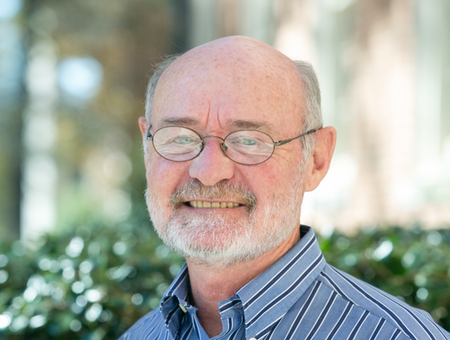
Larry Davenport, professor of biological and environmental sciences, has retired after 40 years of service to Samford University. His career shaped generations of students and left a lasting imprint on Alabama’s environmental landscape.
Davenport joined Samford’s faculty in 1985, continuing a long tradition of botany instruction in the Department of Biological and Environmental Sciences. A native of Seattle, Washington, he said his environmental values were formed early, surrounded by the green and blue landscapes of the Pacific Northwest.
“I spent most of my time outdoors as a kid, and looking back, that’s where I developed my basic environmental ethic,” Davenport said.
He earned a bachelor’s degree in botany from Miami University of Ohio, an interdisciplinary degree that combined science with literature, languages and the humanities. It was there, during his first week of college, that he decided to become a botany professor after being inspired by one of his instructors.
“I remember watching him as much as I was listening to him,” Davenport said. “I liked his lifestyle, and after a few weeks, I decided I wanted to be a botany professor too.”
Davenport completed his doctoral research in biology at The University of Alabama. He was first introduced to Samford when he hosted then-professor Mike Howell for a seminar and later accepted Howell’s invitation to join the faculty.
Though initially uncertain about teaching at a Christian university, Davenport said he found the right fit.
“I had some friends who told me I wouldn’t fit—that Samford was a bad match,” he said. “But I adjusted to Samford and Samford adjusted to me. The main reason it worked is because Samford allowed me to be me.”
Davenport became known for his distinctive, experience-based teaching style. On the first day of class, students often found themselves outdoors identifying trees and observing nature. He taught courses in general botany, plant taxonomy and wetlands ecology and led Jan Term trips to Peru and Belize. He also served as director of Samford’s Vulcan Materials Center for Environmental Stewardship and Education.
“From the beginning, I set out to be a professor who teaches and speaks publicly and does research. And that’s what I got here at Samford,” he said.
One highlight of his career, Davenport said, was stepping off the plane in Iquitos, Peru, in 1991 to begin Samford’s first Amazon rainforest class during Jan Term. “It was just my first real opportunity to see the world, and I fell in love with the place,” he said.
His students left a lasting impact on him as well. “I’ve had plenty of students who have just made me proud,” he said. “At my retirement reception, one of my first advisees, who graduated in 1989, flew in from California just to spend two hours with her old professor.”
Outside the classroom, Davenport led efforts to study and protect the Cahaba lily, a rare aquatic plant native to the Southeast. His work helped spark the creation of the Cahaba Lily Festival in West Blocton and the Cahaba River National Wildlife Refuge. He collaborated with community leaders, scientists and students to promote environmental stewardship and preserve Alabama’s natural beauty.
“Samford has given me the freedom to do what I wanted to do,” he said. “And I think the university has benefited from that too.”
He received the John H. Buchanan Award for Excellence in Classroom Teaching in 1991 and was named Alabama Professor of the Year in 2007 by the Carnegie Foundation for the Advancement of Teaching.
As he steps away from the classroom, Davenport is looking forward to continuing his work through writing and research.
“People say I’m going to be bored,” he said. “I don’t think so. I’m very project-oriented. I’ve got a wildflower book coming out, a travel memoir in my head and even a rock and roll book based on the songs that shaped my life growing up in the ’60s.”
When asked what advice he would leave with the Samford community, Davenport kept it simple: “Be curious,” he said. “Be curious about the world. It’s an amazing place.”
Davenport said what he will miss most is the support and camaraderie of his department.
“For 40 years, my department has supported me physically and emotionally,” he said. “We’re a family and it’s going to be hard to leave that family.”
GIVE: Support impactful work at Howard College of Arts and Sciences.
